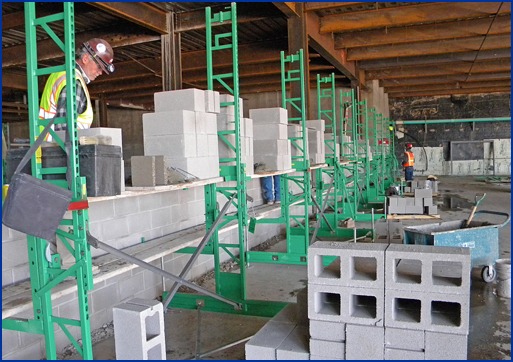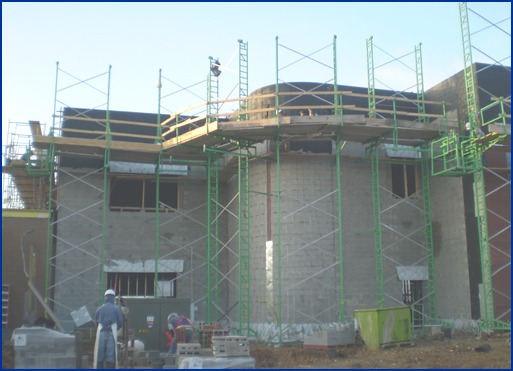When the Block Stops, the Money Stops
The obvious and not-so-obvious benefits of elevated scaffolding.
“When the block stops, the money stops.” That??s the way one mason contractor put it, and he hit the nail right on the head. On the flip side, if your men work faster than you estimated, you spend less money on labor (and still get paid the bid price), and the leftover labor money is yours to keep. Just a little extra production returns a whole lot of extra profit. Only about one in 20 mason contractors really understands how much profit, and understanding it explains how a person can keep taking jobs below his competitor’s cost and stay in business.
While elevating scaffolding offers a significant advance when compared to frame scaffolding by eliminating most of the OSHA headaches, reducing back strain, etc., those may not be the most important benefits in these difficult times. How to beat the competition and make a profit are the important factors.
You see, for so many years, elevating scaffolding has been seen as a fancy way to scaffold a wall, but the positive impact it has on your job cost is real and quite significant. Here is the bottom line, and the answer to the question above: If you ask 20 mason contractors what a 20 percent increase in production does to your profit, 19 of them will say it increases profit by 20 percent, but that is wrong. In most masonry bids, the labor number is five times larger than the profit number. If labor is $100,000, profit might be around $20,000.
Reducing labor by 20 percent, just one-fifth, actually doubles profit. That??s how your competitor can bid at your cost and still make money. All he has to do is work one-fifth faster than you. In lean times, you want to be the guy putting in materials at a rate that is faster than anyone else, and elevating scaffolding lets your men produce at a rate that is a minimum of one-fifth faster without even realizing it.
Elevating scaffolding also has brought labor savings to the scaffold-erection and dismantling side of the equation. It is built once, and then moved from wall to wall with a forklift. Moving elevating scaffolding is, typically, four times faster than frames (at one-quarter of the cost). An experienced crew can move 100 feet to the next wall in about 1.5 hours. It also requires about one-third as many planks as frames.
Elevated scaffolding versus the mast climber
Contractors who use mast climbers typically own elevating scaffolding, too. It costs about four times less than mast climbers. When deciding which one to use, Monty Skinner of Skinner Masonry in Dallas described it this way, “On our 40-foot-and-under work, especially if there are ins and outs, we??ll use our Non-Stop. On 40-foot-and-over long, straight walls, we??ll tend to use our mast climbers, but only if there are multiple moves to make it worth the initial setup.”
Does it make sense to buy elevating scaffolding in this economy? Only if it will pay its own way – meaning, returning more money in labor savings than is going out to pay for the scaffolding. An easy way to find out is to simply figure what it costs you to pay a mason for a month. That varies from $3,800 a month to $8,600 a month, depending on where you live. A rule of thumb is that 105 feet of elevating scaffolding will replace two bricklayers, and it may cost around $28,000 to buy it. Therefore, if you have four months of work ahead, the scaffold can save you $7,600 a month and pay for itself. Go ahead and buy it.
| ??A Product is Born |
| Back in 1970, Justin Breithaupt Jr., co-owner of Non-Stop Scaffolding Inc., found firsthand that a small increase in production causes a big jump in profit. He explains how his scaffold product came to be.
“I was interested in the idea of working waist-high, because I figured it would help me get more work done. There was a local Morgen dealer here, so I rented some. I did a job with it, and sure enough, we finished about 20 percent faster. When I ran the numbers, I was blown away. I more than doubled my profit. I knew right then I would never do another job without elevating scaffolding, but the scaffolding I rented had too many shortcomings, so I designed my own. “I was so excited when I discovered the extra money I could make, I tried every idea I came across that would help my bricklayers work faster. I even made my own corner poles. My jobs were paying off like never before. I was doubling and tripling my estimated profit. “I designed our scaffolding to work in individual towers, instead of having to be braced together continuously, like Morgen and all the other scaffolding available back then. Now you have seven-foot-wide modules you can place exactly where you need them to scaffold really cut-up work. You can turn them sideways to set up deep insets. It sets up just as fast on cut-up work as on straight walls. I also designed it to start on the ground, so you don??t have to run any more walls scaffold-high and move your men.” |


